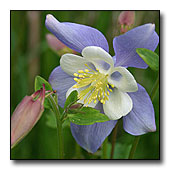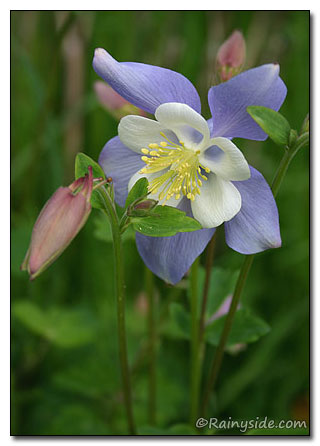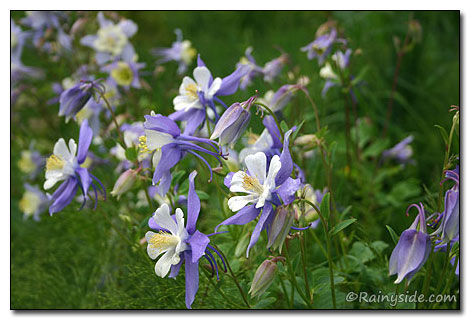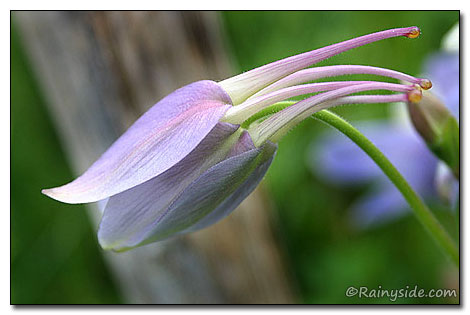Aquilegia coerulea
ROCKY MOUNTAIN COLUMBINE
Family: Ranunculaceae
Pronounced: ack-wi-LEE-gee-uh ce-RU-lee-uh

Quick Jumps
Growing Guide
Rainy Side Notes
GROWING GUIDE

Origin:
Southwest Montana, to northern Arizona and New Mexico.
Plant group:
Perennial.
Hardiness:
Sunset zones: A1-A3, 1-11, 14-24.
USDA zones: 4-7.
Heat zones: 7-1.
Mature size:
Height: 24 inches (60 cm).
Width: 12 inches (30 cm).
Flowering period:
Late spring to midsummer.
Flowering attributes:
The long blue spurs are straight, spreading outwards; the sepals are also blue and the blades of the flowers are white.
Leaf attributes:
Green, two ternate leaves with deeply lobed leaflets.
Light:
Full sun to partial shade.
Soil:
Fertile, moist, well-drained soil.
Feeding:
Add a complete organic fertilizer when planting, and in spring when new growth begins.
Propagation methods:
Sow seed in containers as soon as ripe. Place in cold frame for winter.
Pruning methods:
Dead head spent flowers to prolong bloom. When the flush of flowers is over, cut the plants down to the ground to rejuvenate them. The columbine's new growth is fresh and green the rest of the season.
Pests and diseases:
Powdery mildew and rust may be problems during dry summers. Caterpillars, aphids and leaf miners can also be problems. In spring, leaf miners tunnel through the surface of the leaves, leaving unsightly foliage. To remedy this, cut the whole plant down to the ground after they finish flowering. The leaf miner larvae are gone by the time the second new growth begins.
Rainy Side Notes

…to encounter a grove of these
flowers in the spring mountain
meadows is close to a religious
experience. –Allan M. Armitage
I agree with Armitage, although I have not seen it growing in the wild, but a stand of it in full bloom in my own garden astounds me. Colorado's state flower, Aquilegia coerulea, is the columbine we most often think about when the name comes up. A. coerulea lives longer than most species, sometimes up to four or five years.
The name coerulea means blue and oftentimes is spelled caerulea; however, coerulea, the original spelling, is the accepted one. Whichever way you spell it, this columbine is a lovely flower to grow. I sow mine from seed as I do most aquilegias. Since this genus tends to hybridize freely, a reliable source of seed is necessary to insure you grow the species you want. Bees, flies and hawk moths are the principal pollinators of the blue and white flowers that ebb and flow in rhythm with the slightest breeze.
Indigenous people chewed the seed or used an infusion of roots for abdominal pain or when feeling sick all over. They also used it as a medicine for the heart.

Photographed in author's garden.
Additional Reading
COLUMBINES Aquilegia, Paraquilegia and Semiaquilegia by Robert Nold.
Christopher Lloyd's Garden Flowers: Perennials, Bulbs, Grasses, Ferns by Christopher Lloyd.

Gardening for the Homebrewer: Grow and Process Plants for Making Beer, Wine, Gruit, Cider, Perry, and More
By co-authors Debbie Teashon (Rainy Side Gardeners) and Wendy Tweton
Copyright Notice | Home | Search | Perennials

